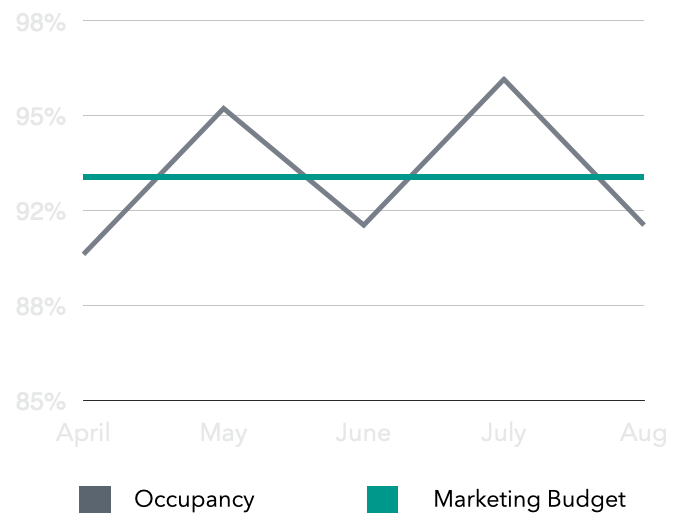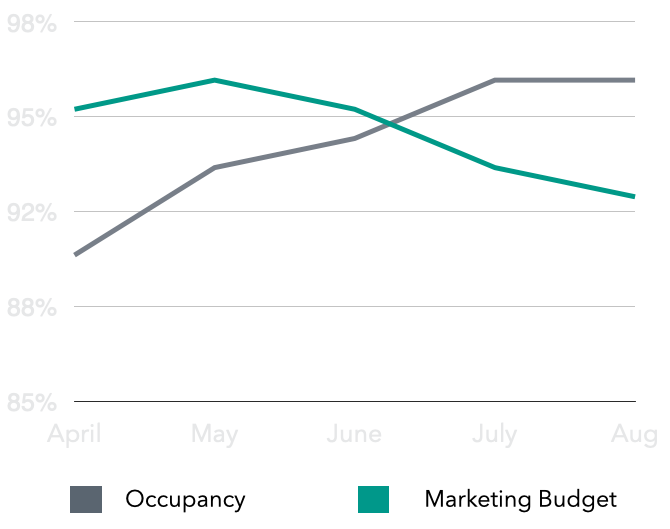When budgeting for your multifamily marketing plan in 2025, are you satisfied with setting the same monthly spending limit?
What if you could set a budget where the spending limit differs each month?
It's easier, of course, to follow the first route. But, eventually, you'll end up wasting money paying for leads when you don't need them. And then, when you need leads, where will you find room in your budget to bump up spending?
It's time to try something different. Your marketing budget should account for changes in demand and occupancy throughout the year and allow you to make dynamic adjustments as needed.
Most multifamily marketers aren't accustomed to this dynamic spending strategy, so we're here to help you start. In this blog, we'll help you answer:
- What is dynamic apartment marketing?
- What information will I need to set a dynamic marketing budget for my apartment community?
Plus, we're providing a free tool to help you set a dynamic marketing budget for your apartments! The link to the tool is at the bottom of the blog.
Let's get started.
Many of the details shared in this blog should sound familiar to RentVision clients who already benefit from a dynamic apartment marketing strategy. This content is meant for educational purposes for non-clients struggling with static marketing and budgets.
What is dynamic apartment marketing?
Dynamic apartment marketing plans are responsive and adapt to your community's occupancy and demand changes. In other words, it's the exact opposite of traditional apartment marketing plans, which are static.
Static Marketing Budget |
Dynamic Marketing Budget |
 |
|
|
|
With dynamic apartment marketing, your occupancy remains stable and on target while your spending constantly changes. Over time, your marketing dollars will deliver the ROI you expect.
What information will I need to set a dynamic marketing budget for my apartment communities?
To set a dynamic apartment marketing budget, there are many considerations you have to account for. But these three items are essential first steps:
1. Identify your dynamic marketing sources
Begin by evaluating where you're currently, or are planning on, spending your marketing budget.
Are your marketing sources dynamic or static?
Digital advertisements are the most dynamic marketing source for apartments. If you're going to shift from a static approach to a dynamic one, consider reallocating your budget from multiple Internet Listing Services packages to Google Ads and Facebook Ads.
Those sources allow you to change spending at any time, which is critical because you will need some dynamic levers in your marketing budget.
Once you've established which sources you plan to use for leads in 2025, the next step is to accurately assess their performance.
You cannot confidently adopt a dynamic strategy unless you're sure you're only paying for marketing sources that deliver your apartment community's most qualified leads.
Pay close attention to Cost Per Lease, which is calculated by dividing a source's monthly cost by the number of leases it generates. The lower the cost, the better.
Source Cost (Monthly) / Number Of Leases = Cost Per Lease
Eliminating any marketing source with a high Cost Per Lease would free up your marketing budget to use more efficiently.
2. Know your community's leasing needs (supply)
After identifying your dynamic marketing sources, you need to know your community's leasing needs for 2025.
You can do this by mapping out all lease expirations scheduled monthly and multiplying that number by your community's average annual turnover rate to determine how many leases you'll need each month.
For example, if ten leases expire next August, and your average yearly turnover rate is 50%, you must earn five signed leases.
3. Know your community's seasonality (demand)
Knowing your community's leasing needs paints a picture of your supply, allowing you to understand how those leasing needs align with your demand.
You can anticipate your 2025 demand by determining your apartment community's unique seasonality by reviewing the last 12 months of organic website traffic data.
Why is organic web traffic a great indicator of your seasonality? Just look at the graphic below:
It displays two years of daily organic website traffic data for one individual apartment community, and you can hardly notice any difference in pattern between the two lines. This is a fantastic representation of how organic web traffic can help you forecast your upcoming year's demand.
You need a higher marketing budget in months when you'll have more vacancies and less organic website traffic. Inversely, it would be best if you allocated less of your marketing budget in months with more increased organic traffic and less vacancy.
In months over the past year, when organic traffic was high, you would've also experienced an uptick in leasing activity in your community. More web traffic equals higher demand. Inversely, months, where fewer visitors came to your website, matched slower leasing activity in your community.
By mapping out your apartment community's monthly leasing needs and demand, you have the data to begin designing a dynamic marketing budget.
You need a higher marketing budget in months when you'll have more vacancies and less organic website traffic. Inversely, it would be best if you allocated less of your marketing budget in months with more increased organic traffic and less vacancy.
If this sounds complicated, don't worry. We've created a free tool that uses your data to set a dynamic marketing budget automatically!
What else should I consider when setting a dynamic apartment marketing budget?
How many units are in your apartment community?
The number of units in your apartment community is essential when determining a maximum and minimum budget for your ads. The more units you have across the property, the more you need to be willing to spend on digital ads because you will naturally need more web traffic to maintain a healthy occupancy.
Let's say you have 200 units at your property, and your turnover rate is 50%. Your goal is to rent 100 units annually to achieve maximum occupancy (obviously unrealistic, but the point remains). Suppose renting one of those units takes 100 visits to your website. In that case, you must attain 10,000 visits annually to your website to accomplish your goal.
Or if you have 400 units and need to rent 200 per year, that requires 20,000 visits to your website.
When you put it in such stark terms, the case for needing a mechanism in your marketing for pushing traffic to your website, like digital ads, becomes self-explanatory. They are your lifeline when things look bleak.
What is your property class?
Different communities have different supply and demand, budgets, and renters, and you can easily see those differences when comparing by property class.
C-class properties don’t need an astronomical digital advertising budget to reach their desired leads, but luxury, A-class communities must maintain higher ad budgets.
Unit counts and property classes directly impact the costs of multifamily PPC campaigns, so be sure to set an appropriate budget that accounts for communities.
What is your average rent?
When deciding your ad budget, your average rent works similarly to your unit count. If you have a higher average rent, you'll need to be able to spend more on your ads. It is one of the key marketing strategies for luxury apartments.
Generally, communities with a high average rent have more high-end features than the average property and reside in larger metro areas with high living costs. Affording that lifestyle is only for specific renter personas. As a result, we have noticed that prospective residents for these communities usually begin looking weeks ahead of making their decision. They are more thorough in their apartment search, completing multiple visits to a community's website before converting to a lead.
When the average time it takes for someone to look at your website or build trust in your apartments is longer, you will have to spend more on your digital ads to keep your community relevant throughout that search. In this case, you'll also compete with properties with bigger marketing budgets.
Regardless of average rent, every community wants a great return on investment regarding digital ads. If you make it a priority to rent units faster, then you'll see a better ROI on ad spending.
Free Dynamic Apartment Marketing Budget Allocation Tool
Download Google Sheet (make a copy)
Download Excel file
To set your dynamic marketing budget, you'll need to enter your yearly turnover rate (or what you'll expect for 2025), your dynamic marketing budget, unit count, organic traffic by month for the past 12 months, and your expected lease expirations for the upcoming year.
Only input the amount of money in your 2025 marketing budget that can be dynamic. For example, you may have to pay a provider to host your community's website and other static marketing expenses that can't be changed or removed from your year-to-year costs. The number you enter into the 'Dynamic Marketing Budget' field should only be the amount of money you've freed up in your total marketing budget after eliminating underperforming sources.
Using your data, the tool calculates how much of your dynamic marketing budget you should spend per month on your various sources and daily spending if you are using Google and Facebook ads.
This tool doesn't show you exactly how much to spend—that's more complicated and requires a detailed analysis of your community's marketing strategy. You can contact one of our advisors to schedule a demo and learn more about RentVision's dynamic marketing strategy.



